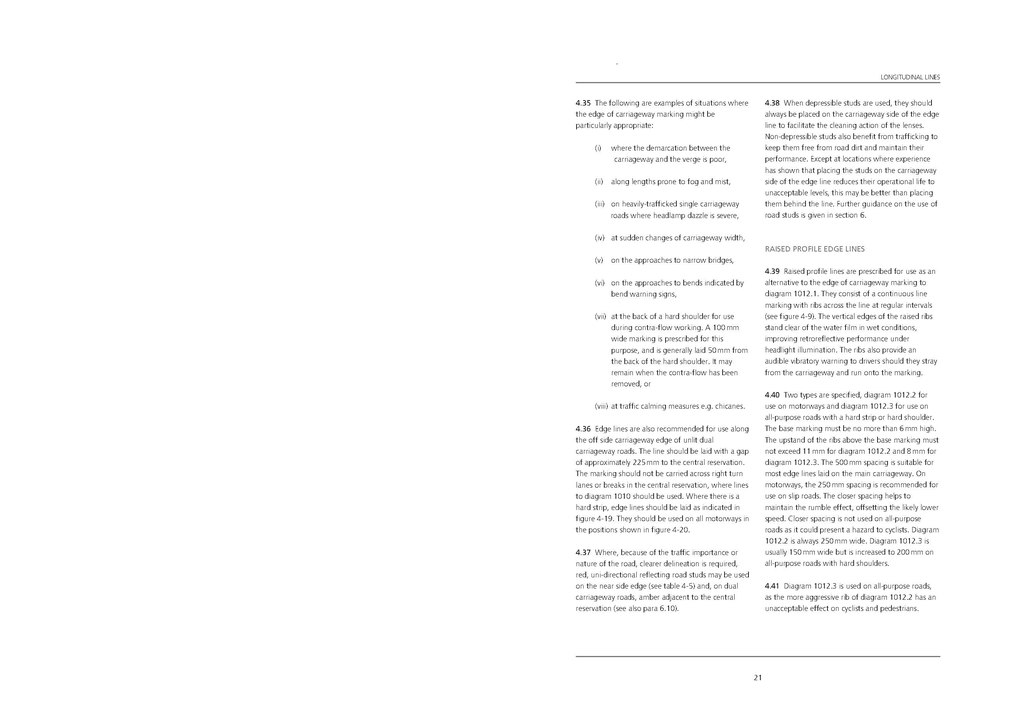4.35 The following are examples of situations where the edge of carriageway marking might be particularly appropriate:
(i) where the demarcation between the carriageway and the verge is poor,
(ii) along lengths prone to fog and mist,
(iii) on heavily-trafficked single carriageway roads where headlamp dazzle is severe,
(iv) at sudden changes of carriageway width,
(v) on the approaches to narrow bridges,
(vi) on the approaches to bends indicated by bend warning signs,
(vii) at the back of a hard shoulder for use during contra-flow working. A 100 mm wide marking is prescribed for this purpose, and is generally laid 50 mm from the back of the hard shoulder. It may remain when the contra-flow has been removed, or
(viii) at traffic calming measures e.g. chicanes.
4.36 Edge lines are also recommended for use along the off side carriageway edge of unlit dual carriageway roads. The line should be laid with a gap of approximately 225 mm to the central reservation. The marking should not be carried across right turn lanes or breaks in the central reservation, where lines to diagram 1010 should be used. Where there is a hard strip, edge lines should be laid as indicated in figure 4-19. They should be used on all motorways in the positions shown in figure 4-20.
4.37 Where, because of the traffic importance or nature of the road, clearer delineation is required, red, uni-directional reflecting road studs may be used on the near side edge (see table 4-5) and, on dual carriageway roads, amber adjacent to the central reservation (see also para 6.10).
4.38 When depressible studs are used, they should always be placed on the carriageway side of the edge line to facilitate the cleaning action of the lenses. Non-depressible studs also benefit from trafficking to keep them free from road dirt and maintain their performance. Except at locations where experience has shown that placing the studs on the carriageway side of the edge line reduces their operational life to unacceptable levels, this may be better than placing them behind the line. Further guidance on the use of road studs is given in section 6.
RAISED PROFILE EDGE LINES
4.39 Raised profile lines are prescribed for use as an alternative to the edge of carriageway marking to diagram 1012.1. They consist of a continuous line marking with ribs across the line at regular intervals (see figure 4-9). The vertical edges of the raised ribs stand clear of the water film in wet conditions, improving retroreflective performance under headlight illumination. The ribs also provide an audible vibratory warning to drivers should they stray from the carriageway and run onto the marking.
4.40 Two types are specified, diagram 1012.2 for use on motorways and diagram 1012.3 for use on all-purpose roads with a hard strip or hard shoulder. The base marking must be no more than 6 mm high. The upstand of the ribs above the base marking must not exceed 11 mm for diagram 1012.2 and 8 mm for diagram 1012.3. The 500 mm spacing is suitable for most edge lines laid on the main carriageway. On motorways, the 250 mm spacing is recommended for use on slip roads. The closer spacing helps to maintain the rumble effect, offsetting the likely lower speed. Closer spacing is not used on all-purpose roads as it could present a hazard to cyclists. Diagram 1012.2 is always 250 mm wide. Diagram 1012.3 is usually 150 mm wide but is increased to 200 mm on all-purpose roads with hard shoulders.
4.41 Diagram 1012.3 is used on all-purpose roads, as the more aggressive rib of diagram 1012.2 has an unacceptable effect on cyclists and pedestrians.
21
